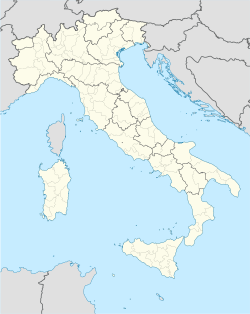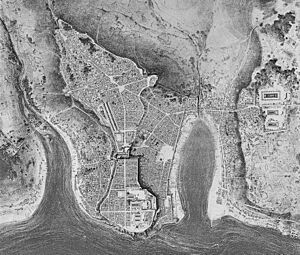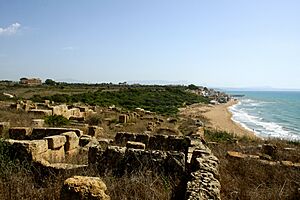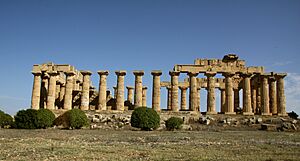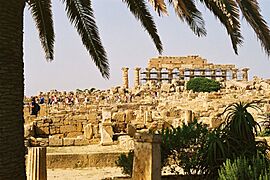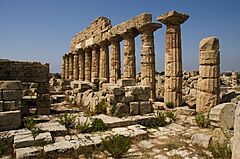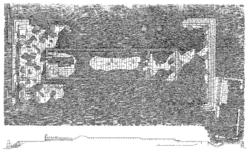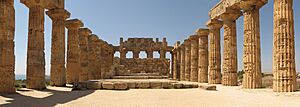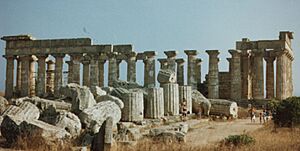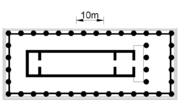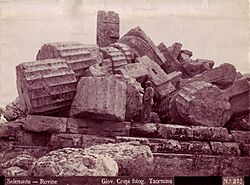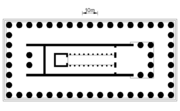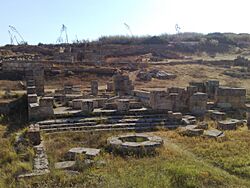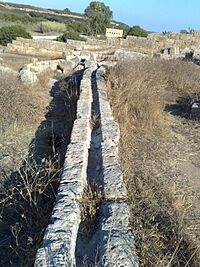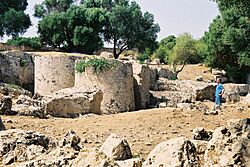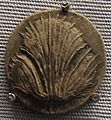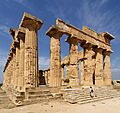Selinunte facts for kids
|
Σελινοῦς
|
|
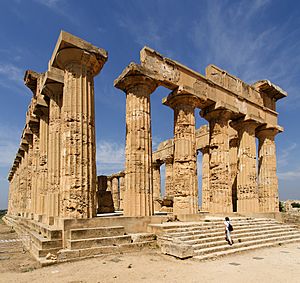
The Temple of Hera at Selinunte (Temple E)
|
|
| Location | Marinella di Selinunte, Province of Trapani, Sicily, Italy |
|---|---|
| Coordinates | 37°35′1″N 12°49′29″E / 37.58361°N 12.82472°E |
| Type | Settlement |
| Area | 270 ha (670 acres) |
| History | |
| Founded | 628 BC |
| Abandoned | Approximately 250 BC |
| Periods | Archaic Greece to Hellenistic period |
| Site notes | |
| Management | Soprintendenza BB.CC.AA. di Trapani |
| Website | Parco Archeologico di Selinunte |
Selinunte was a very rich and large ancient Greek city. It was located on the southwest coast of Sicily in Italy. The city was built between the Cottone and Modione rivers. Today, you can find its ruins in the town of Castelvetrano.
This amazing archaeological site has many huge temples. The oldest ones were built around 550 BC. Five of these temples are located on a high area called an acropolis. At its busiest time, before 409 BC, Selinunte might have had 30,000 people living there, not counting slaves. The city was destroyed and left empty around 250 BC. It was never rebuilt after that.
Contents
The Story of Selinunte
Selinunte was one of the most important Greek settlements in Sicily. It was founded by people from another Sicilian city called Megara Hyblaea. They were led by a man named Pammilus. This happened about 100 years after Megara Hyblaea was founded, around 628 BC. The city's name, Selinunte, comes from the Greek word for wild celery (selinon). Lots of celery grew there! That's why they put a celery leaf on their coins.
Selinunte was the westernmost Greek city in Sicily. This meant they often met the Phoenicians and native Sicilians living nearby. Early on, Selinunte had fights with the Elymian people from Segesta. These two cities often had disagreements and battles.
Selinunte grew very powerful and wealthy. Like many cities in Sicily, it changed from being ruled by a few rich families (an oligarchy) to being ruled by one strong leader (a tyranny). Around 510 BC, a ruler named Peithagoras was overthrown. The city even helped the Carthaginians in a big war in 480 BC.
Before the Athenian attack in 416 BC, Selinunte was a strong and rich city. It had many resources for war on land and sea. Its temples also held a lot of wealth. The city walls covered about 100 hectares. Historians believe between 14,000 and 19,000 people lived there in the 400s BC.
The Sicilian Expedition
In 416 BC, the old fights between Selinunte and Segesta started again. This led to a huge expedition by Athens to Sicily. Selinunte asked Syracuse for help and was able to block the Segestans. But Segesta asked Athens for help.
The Athenians decided to attack Syracuse first. So, Selinunte played only a small part in those battles. Selinunte did send troops to help Syracuse sometimes. Also, a large army from Peloponnesia landed at Selinunte in 413 BC. They were there to help Syracuse.
Selinunte Captured by Carthage
When the Athenian army was defeated, Segesta was left open to its rivals. They gave up some land to Selinunte to end the dispute. But Selinunte was not happy and kept fighting Segesta. So, Segesta asked Carthage for help.
Carthage sent a small army, which helped Segesta defeat Selinunte. The next spring (409 BC), Carthage sent a massive army of 100,000 soldiers. This army was led by Hannibal Mago. They marched straight to Selinunte. The people of Selinunte were not ready for such a big attack.
Many parts of the city walls were broken. Help from Syracuse, Acragas, and Gela did not arrive in time. The Selinuntines fought bravely on their own. They even defended their homes after the walls were broken. But the enemy was too strong. After a ten-day siege, the city was captured. Most of the defenders were killed.
About 16,000 citizens were killed, and 5,000 were taken prisoner. Around 2,600 people, led by Hermocrates of Syracuse, escaped to Acragas. Hannibal destroyed the city walls. But he allowed the survivors to return and live there under Carthaginian rule. Many Selinuntines took this offer. This was confirmed by a peace treaty in 405 BC.
The Final Destruction
Selinunte is mentioned again in 397 BC. They supported Dionysius during his war with Carthage. But the city was given back to Carthage in a peace treaty in 383 BC. Even though Dionysius took it back briefly, it soon returned to Carthaginian control.
In 276 BC, during an expedition by Pyrrhus to Sicily, the people of Selinunte joined Pyrrhus. But by the First Punic War, Selinunte was again under Carthaginian rule. The area around the city became a battlefield between the Romans and Carthaginians.
Around 250 BC, the Carthaginians were pulling back their forces. They moved all the people from Selinunte to Lilybaeum and destroyed the city. It seems Selinunte was never rebuilt after this.
Exploring the Ancient Ruins
The ancient city of Selinunte is located by the sea. It sits between the Modione River to the west and the Cottone River to the east. The city is built on two high areas connected by a narrow strip of land. The southern part, near the sea, has the acropolis. This area has many temples (A, B, C, D, O).
The northern part, on Mannuzza Hill, was where people lived. It also has two ancient cemeteries called necropoleis. Other important ruins are found on hills across the rivers. To the east, there are three more temples (E, F, G). To the west, you can find the oldest parts of Selinunte, including the Sanctuary of the Malophoros. The city had two ports at the mouths of its rivers.
Today, the archaeological park covers about 270 hectares. It is divided into these main areas:
- The Acropolis in the center, with temples and strong walls.
- Gaggera Hill in the West, home to the sanctuary of Malophoros.
- Mannuzza Hill in the north, where ancient houses once stood.
- The East Hill, with more temples.
- The necropoleis (ancient cemeteries).
The Acropolis: City Center and Temples
The acropolis is on a high limestone area. It has a cliff facing the sea on the south side. The northern part narrows to 140 meters wide. The city here was shaped like a trapezoid. It was extended north with a large wall about eleven meters high. The whole area was surrounded by a strong wall with five towers and four gates.
At the entrance to the acropolis is the Tower of Pollux. This tower was built in the 1500s to protect against pirates. It stands on top of an older tower or lighthouse.
The city's layout here dates back to the 300s BC. It has two main streets (9 meters wide) that cross each other at right angles. Smaller roads (5 meters wide) cross these main streets every 32 meters.
On the highest part of the acropolis, you can see the ruins of many Doric temples.
- Temple O and Temple A were built between 490 and 460 BC. Not much is left of them except their stone bases and altars. They looked very similar to Temple E on the East Hill. They had a row of columns around them (6 x 14 columns, each 6.23 meters high). Inside, they had a front porch (pronaos), a main room (naos), and a back room (adyton). In Temple A, two spiral staircases led to an upper level. Temple A's front porch has a mosaic floor with symbols of the Phoenician goddess Tanit. This shows the area was used for religious or home purposes during the Punic period. Temple O might have been for Poseidon or Athena. Temple A might have been for the Dioscuri or Apollo.
- The Shrine is near Temples B and C. It dates from 580 to 570 BC. It has an ancient shape called a Megaron. It might have been used to hold offerings. It was perhaps dedicated to Demeter Thesmophoros.
- Temple B is from the Hellenistic period. It is small (8.4 x 4.6 meters) and not in good shape. It has a porch with four columns. It was probably built around 250 BC, just before Selinunte was abandoned. It shows a small return of the city after its destruction in 409 BC. Its purpose is not clear. Some think it was for a Punic god, perhaps Demeter or Asclepius-Eshmun.
- Temple C is the oldest temple in this area, built around 550 BC. Between 1925 and 1927, fourteen of its columns were put back up. It had a row of columns around it (24 x 63.7 meters, with 6 x 17 columns, each 8.62 meters high). The entrance had eight steps. Inside, it had a porch, a main room (naos), and a back room (adyton). This long, narrow shape is typical of older buildings.
Many parts of the temple show that builders were still experimenting with the Doric temple style. For example, the columns are short and thick. Some are even made from a single stone. Also, the space between columns is not always the same. From this temple, archaeologists found pieces of colorful decorations. They also found a huge 2.5-meter-high clay head of a gorgon from the roof. Three stone carvings (metopes) were also found. They show Perseus fighting the Gorgon, Heracles with the Cercopes, and Apollo's chariot. These are now in the Museo Archeologico di Palermo. Temple C was likely used as an archive because hundreds of seals were found there. It was probably dedicated to Apollo or Heracles.
- Temple D was built around 540 BC. Its west side faces the main north-south street. It had a row of columns (24 x 56 meters, with 6 x 13 columns, each 7.51 meters high). It had a front porch, a long main room, and a back room. It was more standard than Temple C, but still had some older features. For example, the columns were slightly tilted and had different numbers of grooves. Temple D was likely dedicated to Athena or Aphrodite.
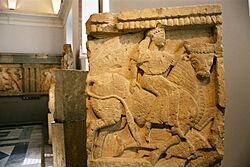
- East of Temple D is a small altar in front of an old shrine called Temple Y. This temple is also known as the Temple of the Small Metopes. The stone carvings found here are 84 centimeters high and date to 570 BC. They show a Sphinx, the Delphic triad (Leto, Apollo, Artemis), and the Rape of Europa. Two other carvings from around 560 BC were reused in a later wall. They show a chariot with Demeter and Kore and a ceremony with three women holding grain. These are now in the Palermo archaeological museum.
Between Temples C and D are the ruins of a Byzantine village from the 400s AD. It was built using recycled stones. Some houses were crushed when Temple C's columns fell. This shows that the earthquake that destroyed the temples happened in the Medieval period.
The northern part of the acropolis has two city areas. They were rebuilt by Hermocrates after 409 BC. The houses are simple and made from recycled materials. Some have crosses carved into them, showing they were later used by Christians.
Further north are the impressive fortifications that protected the acropolis. They include a long covered passage, a deep ditch with a bridge, and three towers. Most of these defenses are from Hermocrates' rebuilding and later repairs. The fact that old temple pieces were used in the walls shows that some temples were already abandoned by 409 BC.
Manuzza Hill: Where People Lived
The main living area of the city was on Manuzza Hill. This whole area was planned with a grid system of long blocks (190 x 32 meters) facing north-south. It was originally surrounded by a defensive wall.
Archaeologists have not dug up this entire area systematically. But some small digs show that people lived here from the very beginning of Selinunte's history (600s BC). After Selinunte was destroyed in 409 BC, this part of the city was not rebuilt. The people who returned lived only on the acropolis, which was easier to defend.
In 1985, a stone structure was found here. It was probably a public building from the 400s BC. Further north, beyond the houses, are two ancient cemeteries: Manuzza and Galera-Bagliazzo.
The Agora: A Huge Public Space
Starting in 2020, archaeologists found the outline of the largest public square (agora) in the ancient world. It covers 33,000 square meters, which is more than twice the size of Rome’s Piazza del Popolo. This Agora, from the 500s BC, was in the center of the city. It was surrounded by public buildings and homes. Earlier digs had only found an empty tomb in the middle, perhaps belonging to the city's founder.
The East Hill: More Grand Temples
There are three temples on the East Hill. Even though they are close together, they were not part of one single sacred area. A wall separated Temple E from Temple F. This group of temples is similar to those in Selinunte’s mother city, Megara. This helps us guess which gods these temples were for.
- Temple E is the newest of the three, built around 460-450 BC. It looks very similar to Temples A and O on the acropolis. Its current look is thanks to a reconstruction done between 1956 and 1959. It had a row of columns (25.33 x 67.82 meters, with 6 x 15 columns, each 10.19 meters high). Many traces of the original plaster that covered it are still visible.
This temple has many staircases that create different levels. Ten steps lead to the entrance on the east side. After the front porch, six more steps lead into the main room (naos). Finally, another six steps lead into the back room (adyton). At the back, separated by a wall, was another porch. A carved stone band (Doric frieze) at the top of the main room's walls showed people. Their heads were made of Parian marble, and the rest from local stone.
Four stone carvings (metopes) from this temple are still preserved. They show Heracles killing the Amazon Antiope, the marriage of Hera and Zeus, Actaeon being torn apart by Artemis’ hunting dogs, and Athena killing the giant Enceladus. All of them are in the Museo Archeologico di Palermo. Temple E was dedicated to Hera, as an inscription on a stone shows. But some experts think it might have been for Aphrodite.
- Temple F is the oldest and smallest of the three. It was built between 550 and 540 BC, similar to Temple C. It has been heavily damaged over time. Its columns were 24.43 x 61.83 meters, with 6 x 14 columns, each 9.11 meters high. It had stone screens (4.7 meters high) between the columns. These screens had fake doors painted on them. The real entrance was at the east end. It's not clear why these unique screens were there. Some think they protected offerings or kept certain rituals private. Inside, it had a porch, a main room, and a back room in one long, narrow structure.
On the east side, two old stone carvings (metopes) were found in 1823. They show Athena and Dionysus killing two giants. Today, they are in the Regional Archeological Museum Antonio Salinas. Experts think Temple F was dedicated to either Athena or Dionysus.
- Temple G was the largest temple in Selinunte. It was also one of the biggest in the entire Greek world. It was 113.34 meters long, 54.05 meters wide, and about 30 meters high. This building was under construction from 530 to 409 BC. But it was never finished. You can see this because some columns don't have their grooves carved yet. Also, huge column pieces were found ten kilometers away at Cave di Cusa, still being cut from the rock.
Among the massive ruins, you can see a row of columns (8 x 17 columns, each 16.27 meters high and 3.41 meters wide). Only one column is still standing. It was put back up in 1832 and is known in Sicilian as “lu fusu di la vecchia” (the old woman's spindle). The inside had a front porch with four columns. Three doors led to the large main room (naos). This room was very big and divided into three sections. The middle section was probably open to the sky. There were two rows of ten thin columns that supported an upper gallery. Two side staircases led to the roof.
At the back of the middle section was a back room (adyton). Inside this adyton, archaeologists found the body of a wounded giant. They also found a very important inscription called the “Great Table of Selinus” (see below). At the very back was another porch that could not be reached from the main room. Some finished columns still show traces of colored plaster. Blocks from the top part of the temple have horseshoe-shaped grooves. Ropes were run through these grooves to lift them into place. Temple G was probably the city's treasury. Inscriptions suggest it was dedicated to Apollo, but some recent studies say it might have been for Zeus.
At the foot of the hill, by the mouth of the Cottone River, was the East Port. It was over 600 meters wide inside. It probably had a wall to protect the acropolis. It was changed in the 300s and 200s BC. It was made larger and had piers and storage areas. Of Selinunte's two ports, the West Port on the Selinus-Modione River was the main one.
The areas outside the city walls were used for trade and port activities. They were built on large terraces on the hillsides. North of the modern village of Marinella is the Buffa necropolis (cemetery).
Gaggera Hill: The Sanctuary of the Malophoros
A path goes from the acropolis, across the Modione River, to the west hill.
On Gaggera Hill, you can find the ruins of a very old sanctuary. It was dedicated to Demeter Malophoros, the goddess of fertility. This complex was built in the 500s BC on the hillside. It was probably a stop for funeral processions before they went to the Manicalunga cemetery.
At first, this place was an open area for religious practices around an altar. Later, a temple and a high wall were built, turning it into a sanctuary. This sanctuary had a rectangular wall (60 x 50 meters). You entered from the east side through a rectangular gate (propylaea). Outside the gate, there was a long porch with seats for visitors. They left many altars and offerings there.
Inside the wall, there was a large altar (16.3 meters long x 3.15 meters wide) in the center. It was on top of a pile of ashes from sacrifices. Between the altar and the temple, there was a canal carved into the rock. This canal brought water to the sanctuary from a nearby spring. Just past the canal is the Temple of Demeter itself. It was shaped like a megaron (20.4 x 9.52 meters). It didn't have a raised platform or columns. It had a front porch, a main room, and a back room with a niche.
South of the gate, attached to the wall, was another area dedicated to Hecate. This was a square area with a shrine in one corner.
Fifteen meters north, there was another square area (17 x 17 meters). It was dedicated to Zeus Meilichios (Honey-sweet Zeus) and Pasikrateia (Persephone). This area has many different structures built in the late 300s BC. It includes a small temple with Doric columns. Outside, people placed many small stone markers (steles) with images of the gods. Ashes and offerings were also found here. This shows a mix of Greek and Punic religious practices.
Many items were found at the Sanctuary of the Malophoros. These include carved scenes from myths, about 12,000 small clay figures (votives) from the 600s to 400s BC. Also, large incense burners shaped like busts of Demeter and perhaps Tanit were found. There was a lot of pottery from Corinth. A carved stone showing the Rape of Persephone by Hades was found at the entrance. Christian lamps were also found, proving that Christians lived in the sanctuary area between the 200s and 400s AD. All these items are kept at the Museum in Palermo.
A little further up Gaggera Hill is the spring that supplied water to the Sanctuary of the Malophoros. Fifty meters downstream is a building that was once thought to be a temple. But it is actually a large fountain. It is rectangular (26.8 meters long x 10.85 meters wide x 8 meters high). It was built with square blocks and had a water tank. It was protected by a porch with columns and a staircase. This building is in the Doric style and dates to the mid-500s BC.
Ancient Cemeteries (Necropoleis)
Around Selinunte, you can find several areas that were used as cemeteries.
- Buffa (late 600s BC and 500s BC): This is north of the East Hill. It has a triangular ditch where offerings were placed. These include clay figures, vases, and animal remains from sacrifices.
- Galera Bagliazzo (500s BC): This is northeast of Mannuzza Hill. Tombs were dug into the rock here. In 1882, the famous Ephebe of Selinus statue was found here. It is now in the Civic Museum of Castelvetrano.
- Pipio Bresciana and Manicalunga Timpone Nero (600s to 400s BC): This is west of Gaggera Hill and is the largest cemetery in Selinunte. It's not clear if it was for the city or a nearby area. Besides burials, there are large jars (amphorae and pithoi) that show people also practiced cremation. The coffins were made of clay or stone.
Cave di Cusa: The Stone Quarries
The Cave di Cusa (Quarries of Cusa) are made of limestone near Campobello di Mazara. They are thirteen kilometers from Selinunte. This is where the stone for Selinunte's buildings came from. The most amazing thing about these quarries is how suddenly work stopped. This happened because of the attack on the city in 409 BC.
The workers, stonecutters, and other laborers left so quickly that today you can see all the steps of the quarrying process. You can see the first deep circular cuts and finished column pieces waiting to be moved. Along with column pieces, there are also some column tops (capitals) and square cuts for other blocks. All these were meant for Selinunte's temples. Some column pieces were ready for transport, and others were abandoned on the road to Selinunte. Some giant columns, definitely for Temple G, are still in the area west of Cave di Cusa, just as they were left.
Ancient Coins of Selinunte
Selinunte made many different coins. The earliest ones, as mentioned before, just show a parsley leaf on one side. Later coins show a figure making a sacrifice on an altar. This altar is for Aesculapius, the god of healing, shown by a rooster below it. This coin likely refers to a story about Selinunte. The city was suffering from a sickness because of the nearby marshy river. But this was cured by draining the land, a plan suggested by Empedocles. A figure standing on some coins is the river-god Selinus. He was believed to help make the city healthy.
The seal of the London School of Hygiene & Tropical Medicine is based on a Selinunte coin from 466 BC. It shows two Greek gods linked to health: Apollo, god of medicine, and his sister Artemis, goddess of hunting. They are in a chariot pulled by horses. The date palm was added to show the School's work in tropical areas. It also connects to Apollo and Artemis, as a palm tree grew to give their mother shade when they were born. Asclepius, Apollo's son, was the god of ancient Greek medicine. He was often shown holding a staff with a snake wrapped around it. This staff with a snake is a symbol of the medical profession. It was placed at the bottom of the seal to highlight the School's medical focus.
Art and Other Finds from Selinunte
- The Great Table of Selinunte was found in Temple G in 1871. It lists the gods worshipped in Selinunte. It says: "The Selinuntines are victorious thanks to the gods Zeus, Phobos, Heracles, Apollo, Poseidon, the Tyndaridae, Athena, Demeter, Pasicrateia and other gods, but especially thanks to Zeus." It also says that after peace, a gold work with the gods' names should be made and put in the Temple of Apollo.
- The art found at Selinunte is very important. Much of it is kept in the Regional Archeological Museum Antonio Salinas. The best examples of Selinunte's unique old artistic style are the stone carvings (metopes).
- The Ephebe of Selinunte is a bronze statue of a young man (an ephebe) offering a drink. It was made in a serious style, typical of Greek art from the west. It dates to 470 BC. Besides the Ram of Syracuse, it is the only large bronze statue from Greek Sicily that has survived. It is kept at Castelvetrano. It was found by chance in 1882 by two boys digging in a cemetery area. It was likely hidden in a clay coffin during dangerous times and never recovered by its owners.
- The cemeteries have given us many old pots and vases. These include Proto-Corinthian, Corinthian, Rhodian, and Attic black figure vases. Selinunte itself did not make fine pottery.
- Some of the most valuable offerings were found in the Sanctuary of the Malophoros. These include small clay statues, pottery, incense-busts, altars, and a carved stone showing the Rape of Persephone by Hades. Christian lamps were also found there. These items are kept in the Museo Archeologico di Palermo.
Metopes of Selinunte
Terracotta Statuettes
General Gallery
See also
- List of ancient Greek cities
- Marinella di Selinunte
- Architecture of Ancient Greece
- Cave di Cusa
- Greek temple
- List of Greco-Roman roofs


